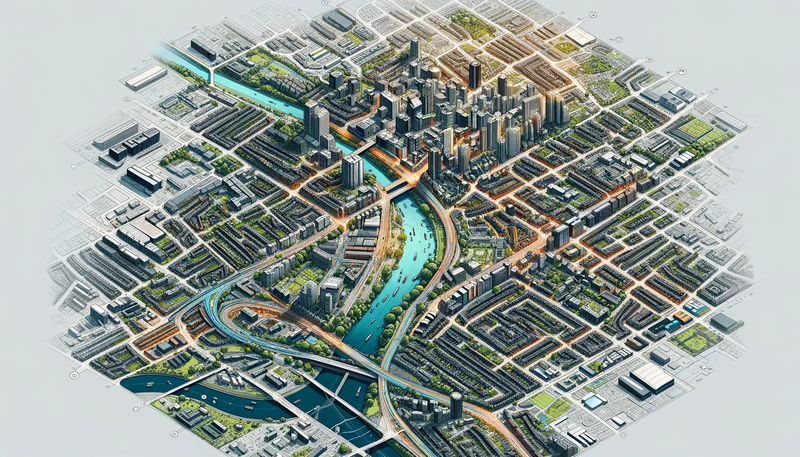Designing Smart Cities: AI-Enhanced Architectural Animation
In an era of unprecedented urbanization, cities are facing many challenges related to infrastructure, transportation, sustainability, and quality of life. As populations continue to grow, urban planners, architects, and policymakers are exploring innovative solutions to create more efficient, livable, and sustainable urban environments. One of the most promising avenues for addressing these challenges is integrating artificial intelligence (AI) into urban planning and architectural animation. This article delves into how AI is revolutionizing the design of smart cities through enhanced architectural animation, highlighting its potential to reshape urban landscapes for the better.
The Urban Challenge

We often describe the 21st century as the "urban century" because more than half of the world's population lives in urban areas for the first time in history. This rapid urbanization presents a complex set of challenges for city planners, including:
- Congestion and Traffic: Increasing traffic congestion not only leads to longer commutes but also contributes to pollution and reduced quality of life.
- Environmental Sustainability: Cities handle a significant portion of global greenhouse gas emissions. Finding sustainable solutions is paramount.
- Resource Management: The efficient use of resources such as energy, water, and land is essential for urban sustainability.
- Housing Shortages: Many cities face housing shortages, leading to skyrocketing prices and increased inequality.
- Aging Infrastructure: Much of the world's urban infrastructure is aging and in need of modernization.
The concept of "smart cities" emerged as a response to these challenges. Smart cities leverage technology and data to improve the quality of life for residents while enhancing sustainability and efficiency. With its ability to analyze vast datasets and make informed decisions, AI plays a pivotal role in this transformation.
AI in Urban Planning and Architectural Animation
AI is reshaping urban planning and architectural animation in several key ways:
- Data-Driven Decision-Making: AI algorithms can process and analyze massive amounts of data, including demographic information, traffic patterns, energy consumption, and environmental factors. This data-driven approach enables city planners to make more informed decisions.
- Traffic Management: AI-powered systems can optimize traffic flow, reduce congestion, and improve transportation infrastructure. Adaptive traffic signals, for example, can respond in real-time to changing traffic conditions.
- Urban Design: AI can assist architects and urban planners in creating more efficient and sustainable urban spaces. It can analyze building layouts, materials, and energy usage to optimize designs for environmental impact and energy efficiency.
- Predictive Analytics: AI can predict future urban trends and challenges, allowing cities to proactively address issues such as population growth, climate change, and infrastructure needs.
- Energy Efficiency: AI-driven systems can monitor and optimize energy use in buildings and city infrastructure. For instance, smart grids can balance energy supply and demand more efficiently.
- Realistic Visualization: AI-enhanced architectural animation allows stakeholders to visualize proposed urban projects in realistic detail. This aids in communication, public engagement, and decision-making.
- Safety and Security: AI-powered surveillance and monitoring systems enhance public safety by identifying potential security threats and responding in real-time.
- Waste Management: AI can optimize waste collection routes and recycling programs, reducing costs and environmental impact.
- Data Privacy and Security: The collection and analysis of vast amounts of data raise concerns about privacy and data security. Ensuring that sensitive information is protected is crucial.
- Bias and Fairness: AI algorithms can perpetuate biases present in historical data. We must make efforts to identify and mitigate biases in decision-making processes.
- Accessibility: Ensuring that smart city solutions are accessible to all residents, including those with disabilities, is a priority. AI should be harnessed to improve inclusivity.
- Transparency and Accountability: Decisions made by AI systems must be transparent and subject to oversight. Accountability mechanisms must be in place.
- Job Displacement: Automating certain tasks through AI may lead to job displacement in some industries. Preparing the workforce for these changes is crucial.
Case Studies in AI-Enhanced Smart Cities
Let's explore a few case studies to illustrate the impact of AI-enhanced architectural animation in the development of smart cities:
1. Singapore's AI-Powered Urban Planning: Singapore, known for its innovative urban planning, has been using AI to create predictive models of urban development. By analyzing historical data, AI helps expect future trends and challenges, enabling proactive planning and infrastructure development.
2. Barcelona's Superblocks: Barcelona's "superblocks" initiative aims to reclaim public spaces from cars and create pedestrian-friendly areas. AI-powered simulations and visualizations were used to show the benefits of this urban redesign to residents and stakeholders.
3. Autonomous Vehicles in Phoenix: The city of Phoenix, Arizona, is testing autonomous vehicles to address transportation challenges. AI simulations have played a crucial role in modelling traffic scenarios and assessing the impact of autonomous vehicles on the city's road network.
4. Copenhagen's Climate Adaptation Plan: Copenhagen, a pioneer in urban sustainability, is using AI to model and visualize the potential impacts of climate change, such as rising sea levels. This aids in planning for necessary infrastructure adaptations.
Challenges and Ethical Considerations

While AI holds immense promise for smart cities, it also raises important challenges and ethical considerations:
Conclusion
AI-enhanced architectural animation is at the forefront of the smart city revolution. By harnessing the power of artificial intelligence, cities can make data-driven decisions, optimize urban planning, and create more sustainable, livable environments. The potential for AI to transform our cities is vast, but it must be harnessed responsibly, with careful consideration of ethical and societal implications. As we continue to confront the challenges of urbanization, AI offers a path toward smarter, more resilient, and more inclusive cities.
Our Services
View some of our most popular services below.











